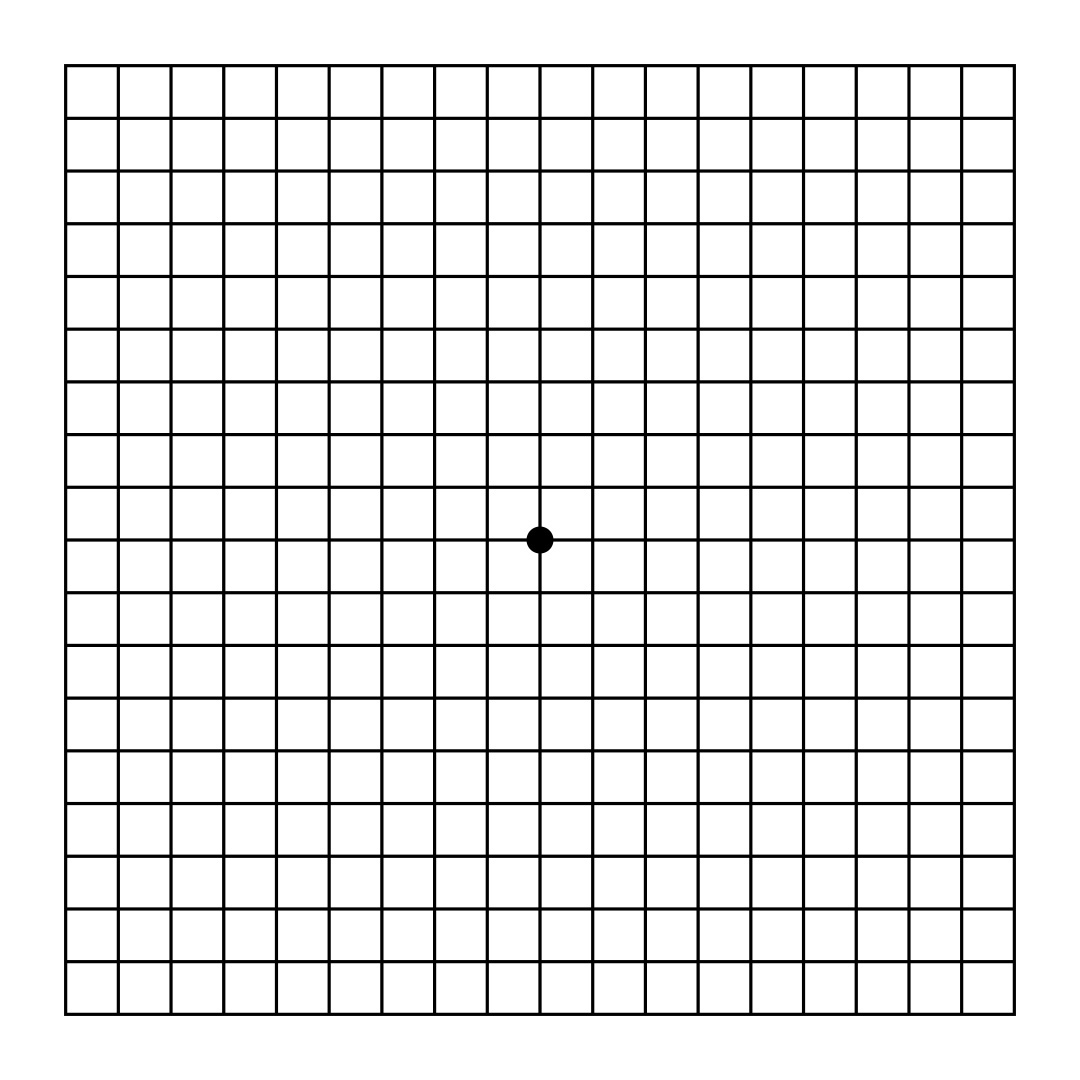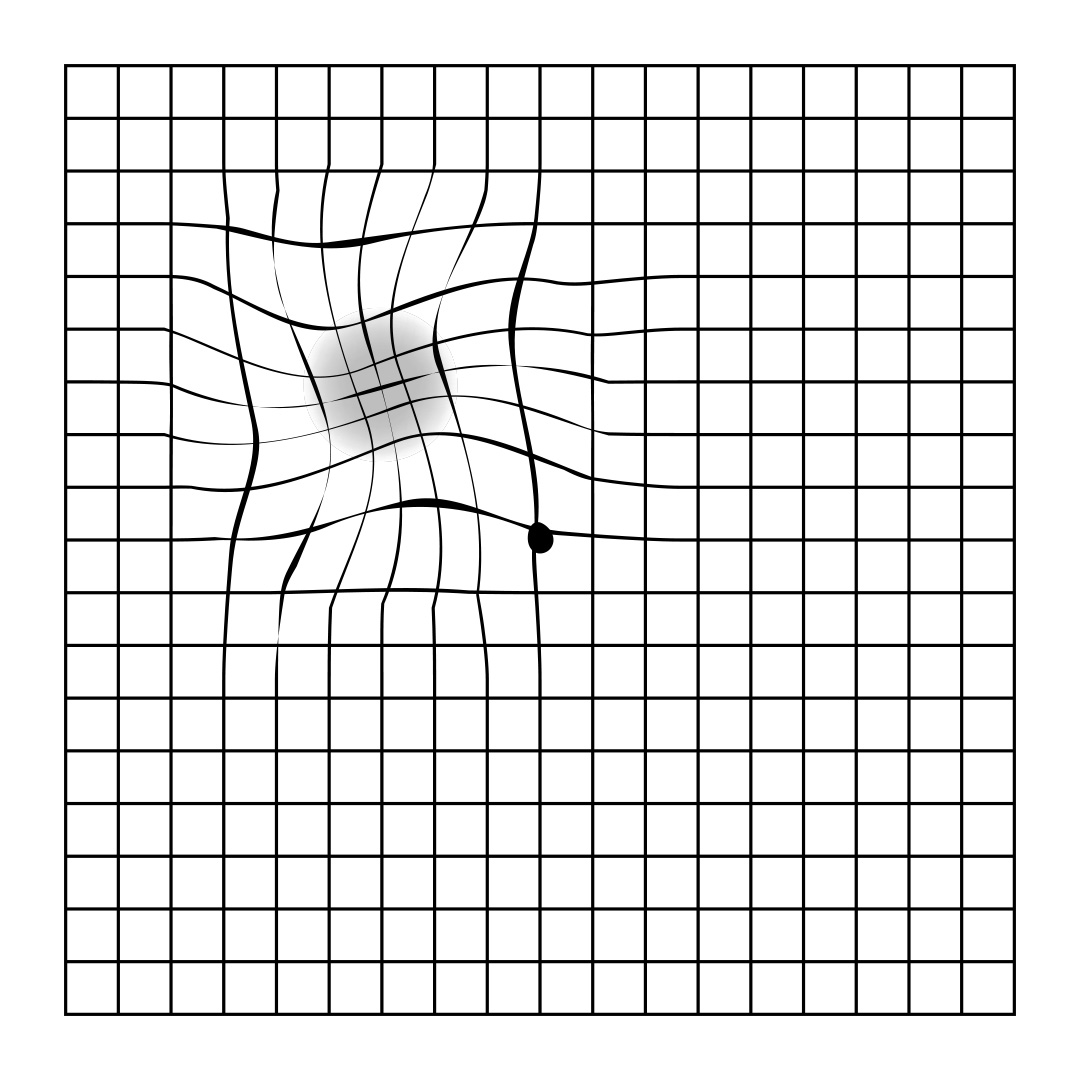Amsler grid: Macular degeneration test at home

Table of contents
The Amsler grid test is commonly used to detect and monitor macular degeneration, a leading cause of vision loss in older adults. Early detection and close monitoring can potentially slow the progression of vision loss.
Just like any online eye test, Amsler grids are most effective when taken in conjunction with regular eye exams and professional medical guidance. Be sure to consult your eye care professional to schedule an exam or speak about any concerns you might have.
To introduce you to the basics of macular degeneration and Amsler tests, our eye care experts have answered some common questions. You'll find step-by-step instructions about how to use an Amsler grid and information about interpreting the results. You can also download a free printable Amsler grid to use at home.
Read more below and find out if you should be taking an Amsler test and, if so, how often you should be doing it. Or jump straight to the instructions for using the Amsler grid.
What is the Amsler eye test?
An Amsler test is a simple and effective vision test used to detect and monitor changes in an individual's central vision. It is used by those who may have, or are at risk of, developing age-related macular degeneration (AMD).
The Amsler chart itself consists of a white background with black lines that form a square grid pattern. In the center of the grid, there is a single dot that acts as a focal point.
Self-testing with an Amsler grid is important for your visual health. Please keep in mind, however, that a trained eye care professional can more accurately interpret your results and provide appropriate follow-up care. Always consult your provider with any changes or abnormal and ambiguous test findings.
How to use the Amsler grid chart
An Amsler grid is a non-invasive and painless test. It can be done quickly and easily at home or during a routine eye exam. Follow these step-by-step instructions on how to perform the Amsler grid test yourself.
- Hold the grid 12 to 15 inches away from your face in a well-lit area.
- Cover one eye.
- Focus on the centre dot for approximately 10 seconds with your uncovered eye. Take note if any lines or areas look blurry, wavy, dark, or are missing.
- Repeat with the other eye.

Tips for accurate results
For the most accurate results, wear any reading glasses, including bifocals, you’d typically use to read. Repeat the test once a week or as recommended by your eye care specialist. It's also important to document your results to properly track the disease. If you notice any changes in your vision, contact your eye care specialist immediately.
Pro tip: Did you know that Amsler grids can be printed or used on a computer screen or tablet? Be sure to place the paper grid or screen at eye level to ensure the most accurate results.
How to interpret the Amsler test
To a healthy eye without macular degeneration, all areas of an Amsler grid should appear clear and uniform. Each line and square can be seen clearly and brightly through the open eye. Additionally, no broken lines appear and all squares should be present.
Abnormal findings or Amsler distortion can indicate a possible vision change or problem. If you have macular degeneration or another central vision problem, the lines on an Amsler grid may appear wavy, curved, or distorted like on the grid pictured below. You may also notice a blank or dark area in the middle of the grid.

It's imperative to seek immediate medical attention from an eye care professional if any changes or distortions are detected during the Amsler grid test. Early detection and treatment of AMD can help prevent further vision loss and improve the chances of preserving central vision.
Please note that while Amsler grids can be a useful tool and highly accurate in monitoring changes in your vision, they’re not intended to diagnose or treat any medical condition. Remember they’re also not a substitute for regular eye exams or professional medical advice. If you notice any changes in your vision or have any concerns about your eye health, consult your eye care specialist.
What is macular degeneration?
Macular degeneration, also known as age-related macular degeneration (AMD), is a medical condition that affects the central part of the retina, called the macula. The macula is responsible for sharp, central vision needed for tasks like reading and driving. The disease is most commonly seen in people over the age of 60. Over time, macular degeneration can cause a gradual loss of central vision.
The signs of macular degeneration can vary, but some common symptoms include blurry or distorted vision, a dark or empty area in the center of the visual field, and difficulty seeing fine details. There are two types of macular degeneration: dry and wet.
- Dry macular degeneration is more common and progresses slowly. Deposits of lipids, proteins, and cellular debris build up under the retina, thinning the macula.
- Wet macular degeneration is less common but can progress rapidly and cause more severe vision loss. It occurs when irregular blood vessels begin to grow under the macula and leak fluid into the retina.
Who needs to take the Amsler grid test?
While the exact cause of dry macular degeneration is not clear, research indicates age and environmental factors may be contributing factors. Take a look at some common factors that can determine who is at risk for macular degeneration:
- Age – Macular degeneration is more common in adults over the age of 60.
- Family history – Genetics and the disease are shown to have a connection.
- Cardiovascular disease – Heart disease diseases can indicate a higher risk for macular degeneration.
- Smoking – Smoking cigarettes or being regularly exposed to secondhand smoke greatly increases your eye and other diseases.
- Obesity – Research indicates that obesity may affect the progression of macular degeneration to the more severe form of the disease.
One of the main benefits of Amsler grid testing is early detection of potential vision problems. The results can alert you to the onset of wet macular degeneration at an earlier, more treatable stage, allowing for prompt treatment and possible prevention of further central vision loss.
While there is no cure for macular degeneration, there are treatment options for wet AMD. Your eye care specialist may treat your AMD with a drug called anti-VEGF. In addition, they may recommend tips to improve eyesight and reduce macular degeneration risk such as diet changes. Filtering blue light does more than prevent eye strain, it can reduce the risk of macular degeneration as well.
Did you know? Wet macular degeneration is only caused by the dry form of the disease. Fortunately, dry macular degeneration does not always turn into the more serious wet type.
How often should you take the Amsler test?
An eye care specialist may recommend testing between once per day and once per week. Always consult your eye doctor to determine the frequency appropriate for your risk level or disease progression.
Unlike exams such as an online astigmatism test that can be taken once, Amsler grids must be used regularly to be effective.
Can the Amsler grid detect glaucoma?
Amsler grids are primarily used to detect macular diseases. They're most commonly used as a macular degeneration chart to detect and track the disease. While Amsler test results can alert individuals to abnormalities in their vision related to glaucoma, it remains pertinent to undergo a comprehensive eye exam to accurately diagnose and rule out other diseases.
Closing thoughts from Lentiamo
Prevention is key when it comes to eye health. To take care of your eyes and vision, it's important to schedule regular appointments with your eye care professional.
The experts at Lentiamo hope this information about Amsler grids and macular degeneration has been helpful. Speak to an eye care provider if you think you may be at risk for macular degeneration. They can perform comprehensive exams and advise you about the specifics of your eyes and visual health.








Comments